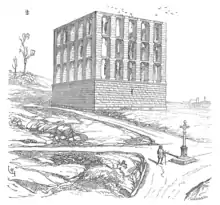Gibbet of Montfaucon
The Gibbet of Montfaucon (French: Gibet de Montfaucon) was the main gallows and gibbet of the Kings of France until the time of Louis XIII of France. It was used to execute criminals, often traitors, by hanging and to display their dead bodies as a warning to the population. It was a large structure located at the top of a small hill near the modern Place du Colonel Fabien in Paris, though during the Middle Ages it was outside the city walls and the surrounding area was mostly not built up, being occupied by institutions like the Hôpital Saint-Louis from 1607, and earlier the Convent of the Filles-Dieu[1] ("Daughters of God"), a home for 200 reformed prostitutes, and the leper colony of St Lazare.[2]
 Gibbet of Montfaucon, after Viollet-le-Duc | |
| Coordinates | 48.8778°N 2.3680°E |
|---|---|
| Location | Paris, France |
| Type | Gallows |
| Length | 12 to 14 m (39 to 46 ft) |
| Width | 10 to 12 m (33 to 39 ft) |
| Height | 4 to 6 m (13 to 20 ft) |
| Completion date | Probably 13th century Destroyed 1760 |
First built in the late 13th century, it was used until 1629 and then dismantled in 1760. As reconstructed in images by Eugène Viollet-le-Duc it had three sides, and 45 compartments in which people could be both hanged and hung after execution elsewhere. A miniature of about 1460 from the Grandes Chroniques de France by Jean Fouquet, and also a print of 1609, show a somewhat less substantial structure than that in the reconstructions, which may, like others by Viollet-le-Duc, make the structure grander and more complex than was actually the case. The miniature shows bodies hanging from beams running across the central space, resting on the piers, but Viollet-le-Duc shows slabs running round the sides. Both show a substantial platform in masonry, which ran round a central space at ground level in the reconstructions, entered by a tunnel through the platform, closed by a gate. Another print of 1608 shows only two tiers of compartments rather than the three of Viollet-le-Duc. The English travel writer Thomas Coryat saw it at about the same time and described it as "the fayrest gallowes that I ever saw, built on a little hillocke ... [with] fourteen pillars of free stone".[3]
The structure was also used for displaying the bodies of those executed elsewhere; in 1416 the remains of Pierre des Essarts were finally handed back to his family after three years at Montfaucon.[4] Like an alarming number of other victims, Essarts had been one of the four royal treasurers.
The gibbet was a great favourite of popular historians and historical writers of the 19th century, appearing in historical novels including The Hunchback of Notre-Dame (1831) by Victor Hugo,[5] Crichton (1837) by William Harrison Ainsworth,[6] and La Reine Margot (1845) by Alexandre Dumas; both the last two tales centred on the St. Bartholomew's Day Massacre.[7]
Executions


Those executed or displayed there include:
- 1278: Pierre de La Brosse, favourite and grand chamberlain of Philippe III the Bold.
- 1315: Enguerrand de Marigny, former treasurer for Philippe IV le Bel.
- 1322: Giraud Gayte, treasurer for Philippe V of France.
- 1322: Jourdain de l'Isle, Gascon brigand, nephew by marriage of Pope John XXII.
- 1328: Pierre de Rémi, seigneur de Montigny, treasurer for Charles IV of France.
- 1378: Jacques de Rue, chamberlain of Charles II of Navarre.
- 1378: Pierre du Tertre, secretary of Charles II of Navarre.
- 1409: Jean de Montagu, treasurer of Charles VI.
- 1413: Pierre des Essarts, also treasurer for Charles VI
- 1457: Regnier de Montigny, brigand from the "coquillard".
- 1460: Colin de Cayeux, brigand from the "coquillards".
- 1484: Olivier Le Daim, confidant of Louis XI.
- 1525: Barbiton, Jean Charrot, Jean Lubbe, brigands
- 1527: Jacques de Beaune, baron de Semblançay, vicomte de Tours, Surintendant des Finances for François I of France.
- 1572: The body of Admiral Gaspard II de Coligny, comte de Coligny, slain in the St. Bartholomew's Day massacre, was displayed there, hung by the feet.
References
| Wikimedia Commons has media related to Gibet de Montfaucon. |
- Lazare, Félix; Lazare, Louis Clément (1855). Dictionnaire administratif et historique des rues de Paris et de ses monuments (in French). Paris: Bureau de la Revue Municipal. p. 243.
- Sumption, Jonathan (1999). The Hundred Years War, Volume 1: Trial by Battle. University of Pennsylvania Press. p. 8. ISBN 9780812216554.
- Hamilton, E. Blanche (April 1886). "Paris under the Last Valois Kings". The English Historical Review. 1 (2): 267. doi:10.1093/ehr/I.II.260. JSTOR 546891.
- Lacroix, Paul (1874). Manners, Customs, and Dress During the Middle Ages, and During the Renaissance Period. New York: D. Appleton & Co. pp. 423–424.
- [ Book 11, Chapter 4]
- Ballad in Chapter 1 Charles IX at Montfaucon, and later when Coligny hangs there.
- [ La Reine Margot, in translation]
- Knecht, Robert J. (2002). The French religious wars: 1562-1598. Oxford: Osprey. pp. 51–52. ISBN 978-1841763958.